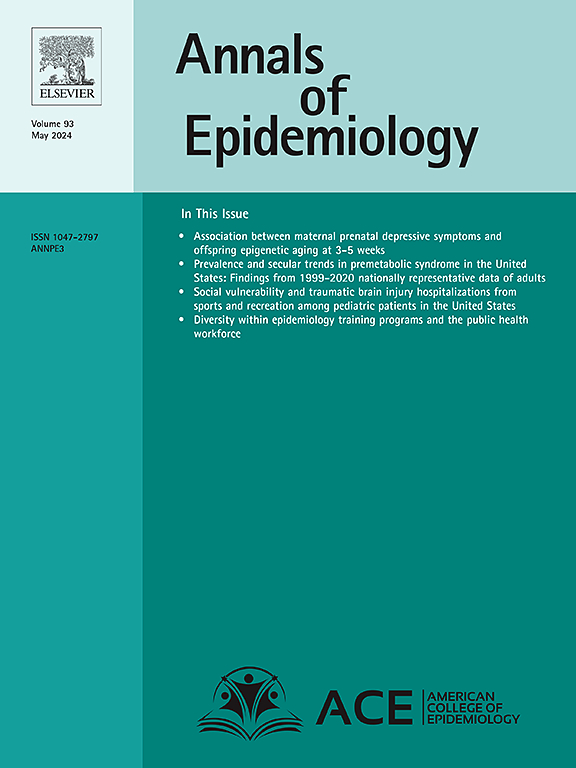An equity audit on program completion among women with a history of gestational diabetes in a state-funded diabetes and cardiovascular risk reduction program
IF 3.3
3区 医学
Q1 PUBLIC, ENVIRONMENTAL & OCCUPATIONAL HEALTH
引用次数: 0
Abstract
Purpose
To assess the completion of the type 2 diabetes, heart disease and stroke prevention program (the Life!) among women with a history of gestational diabetes mellitus (GDM) according to participants’ characteristics.
Methods
Data from women with a history of GDM enrolled in the Life! program in Victoria, Australia, between 2014 and 2022 were analysed. Completion rates were assessed using the PROGRESS-Plus (Place of residence, Race/ethnicity/culture/language, Occupation, Gender/sex, Religion, Education, Socioeconomic status, and Social capital Plus age and smoking) framework. Multivariable logistic regression model was fitted.
Results
A total of 2399 women with a history of GDM were enrolled in the program, of which 55 % completed it. Characteristics associated with higher completion rates included being from metropolitan areas (AOR = 1.52, 95 % CI: 1.14–2.01) compared with being from regional areas, having a body mass index in a normal range (AOR = 1.50, 95 % CI: 1.06–2.15) compared with having overweight or obesity, having middle income (AOR = 1.41, 95 % CI: 1.01–1.98) compared with having low- or high-income, and enrolment after 2019 (AOR = 2.3, 95 % CI:1.80–3.06) compared with enrolment in 2019 or earlier. Conversely, having a South or Central Asian background (AOR = 0.65, 95 % CI: 0.46–0.92) is associated with a lower completion rate compared with being from Australia.
Conclusion
Characteristics associated with lower completion rates among women with prior GDM in a cardiometabolic risk reduction program included residing in rural and remote areas, having an elevated BMI (in the overweight or obesity range), low or high income, enrolment in 2019 or earlier and being of South or Central Asian background.
在国家资助的糖尿病和心血管风险降低项目中,对有妊娠糖尿病史的妇女完成项目的公平性审计
目的评估妊娠期糖尿病(GDM)病史妇女的2型糖尿病、心脏病和脑卒中预防计划(Life!)的完成情况。方法:数据来自Life!2014年至2022年期间在澳大利亚维多利亚州开展的项目。使用PROGRESS-Plus(居住地、种族/民族/文化/语言、职业、性别/性别、宗教、教育、社会经济地位和社会资本+年龄和吸烟)框架评估完成率。拟合多变量logistic回归模型。结果共有2399名有GDM病史的女性参加了该项目,其中55% %完成了该项目。与较高完成率相关的特征包括:来自大都市地区的学生(AOR = 1.52, 95 % CI: 1.14-2.01)与来自地区的学生相比,体重指数在正常范围内的学生(AOR = 1.50, 95 % CI: 1.06-2.15)与超重或肥胖的学生相比,中等收入的学生(AOR = 1.41, 95 % CI: 1.01-1.98)与低收入或高收入的学生相比,2019年以后入学的学生(AOR = 2.3, 95 % CI: 1.80-3.06)与2019年或更早入学的学生相比。相反,南亚或中亚背景(AOR = 0.65, 95 % CI: 0.46-0.92)与来自澳大利亚的人相比,完成率较低。结论:在先前患有GDM的女性中,与心脏代谢风险降低计划完成率较低相关的特征包括居住在农村和偏远地区、BMI升高(在超重或肥胖范围内)、低收入或高收入、2019年或更早入组、南亚或中亚背景。
本文章由计算机程序翻译,如有差异,请以英文原文为准。
求助全文
约1分钟内获得全文
求助全文
来源期刊

Annals of Epidemiology
医学-公共卫生、环境卫生与职业卫生
CiteScore
7.40
自引率
1.80%
发文量
207
审稿时长
59 days
期刊介绍:
The journal emphasizes the application of epidemiologic methods to issues that affect the distribution and determinants of human illness in diverse contexts. Its primary focus is on chronic and acute conditions of diverse etiologies and of major importance to clinical medicine, public health, and health care delivery.
 求助内容:
求助内容: 应助结果提醒方式:
应助结果提醒方式:


